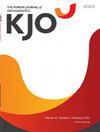Type of tooth movement during en masse retraction of the maxillary anterior teeth using labial versus lingual biocreative therapy in adults: A randomized clinical trial
IF 1.9
3区 医学
Q1 Dentistry
引用次数: 7
Abstract
Objective The objective of this two-arm parallel trial was to compare the type of tooth movement during en masse retraction of the maxillary anterior teeth using labial versus lingual biocreative therapy. Methods Twenty-eight subjects were randomized in a 1 : 1 ratio to either the labial or lingual group. En masse anterior retraction was performed using labial biocreative therapy in group A and lingual biocreative therapy in group B. Cone beam computed tomography scans were taken before and after retraction and the primary outcome was the type of tooth movement during anterior retraction. Data were analyzed using paired t-tests for comparisons within each group and independent-sample t-test for comparison of the mean treatment changes between the two groups. Results Significant differences were found between the two groups in relation to the type of tooth movement (labiolingual inclination of the central incisor; mean difference, 5.85 ± 1.85°). The canine showed significant distal tipping in the lingual group (mean difference, 6.98 ± 1.25°). The canine was significantly more intruded in the lingual group (mean difference, 1.67 ± 0.49 mm). Good anchorage control and significant soft tissue changes occurred in both groups. No serious adverse effects were detected. Conclusions With a 10-mm retraction hook, the labial biocreative technique with the reverse curve overlay provided anterior retraction with good torque control, while in the lingual group, anterior retraction occurred with controlled tipping movement with significant distal tipping and intrusion of the canine (trial registration: The trial was registered at ClinicalTrials.gov [NCT03239275]).在成人中使用唇与舌生物创造疗法的上颌前牙大规模后缩时牙齿移动类型:一项随机临床试验
目的:本研究的目的是比较唇部生物创造疗法和舌部生物创造疗法在上颌前牙大规模后缩过程中牙齿移动的类型。方法28例患者按1:1的比例随机分为唇部组和舌部组。A组采用唇部生物创造疗法,b组采用舌部生物创造疗法,进行前缩,前后进行锥形束计算机断层扫描,主要观察前缩时牙齿移动的类型。每组间比较采用配对t检验,两组间平均治疗变化比较采用独立样本t检验。结果两组在牙齿运动类型(中切牙唇舌倾斜;平均差为5.85±1.85°)。舌组犬的远端倾斜明显(平均差为6.98±1.25°)。舌组犬的侵入程度显著高于舌组(平均差异为1.67±0.49 mm)。两组均有良好的支抗控制和明显的软组织改变。未发现严重的不良反应。结论:在10 mm的后拉钩下,唇侧生物创造技术与反向曲线覆盖可以提供良好的扭矩控制,而在舌组中,前拉发生可控的倾斜运动,但明显的远端倾斜和犬侵入(试验注册:试验注册在ClinicalTrials.gov [NCT03239275])。
本文章由计算机程序翻译,如有差异,请以英文原文为准。
求助全文
约1分钟内获得全文
求助全文
来源期刊

Korean Journal of Orthodontics
Dentistry-Orthodontics
CiteScore
2.60
自引率
10.50%
发文量
48
审稿时长
3 months
期刊介绍:
The Korean Journal of Orthodontics (KJO) is an international, open access, peer reviewed journal published in January, March, May, July, September, and November each year. It was first launched in 1970 and, as the official scientific publication of Korean Association of Orthodontists, KJO aims to publish high quality clinical and scientific original research papers in all areas related to orthodontics and dentofacial orthopedics. Specifically, its interest focuses on evidence-based investigations of contemporary diagnostic procedures and treatment techniques, expanding to significant clinical reports of diverse treatment approaches.
The scope of KJO covers all areas of orthodontics and dentofacial orthopedics including successful diagnostic procedures and treatment planning, growth and development of the face and its clinical implications, appliance designs, biomechanics, TMJ disorders and adult treatment. Specifically, its latest interest focuses on skeletal anchorage devices, orthodontic appliance and biomaterials, 3 dimensional imaging techniques utilized for dentofacial diagnosis and treatment planning, and orthognathic surgery to correct skeletal disharmony in association of orthodontic treatment.
 求助内容:
求助内容: 应助结果提醒方式:
应助结果提醒方式:


